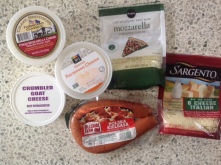I am reluctant to consider myself old even though I have been retired for almost seven years, and I just hit 70. I find it even more disturbing that my ideas may be stuck in the past and as outdated as those of my elders whom I criticized 20-30 years ago. Thus, it has been with both reluctance and joy to learn that there is a whole new generation out there defending processed foods. Last week I reviewed Future Foods by David Julian McClements on this site. Next month I will review Molecules, Microbes, and Meals by Alan Kelly. Below I offer some thoughts on this generational shift after reading these two books.

McClements and Kelly are much more positive and less defensive about processed foods than I am. They either don’t read books by Michael Pollan, Marion Nestle and other critics of food science or they don’t let the criticisms affect them. While I contorted myself to explain why there are so many chemicals in our food In Defense of Processed Food, it is just stated that food additives are needed to prevent food waste and keep foods safe in Future Foods. There is also a nice explanation of the functional properties of transglutaminase in Molecules, Microbes, and Meals that completely ignores the negative press it received in sources like Badditives. While my writing is clearly on the defensive when it comes to ultra-processed foods, their attitude seems to be it is what it is, and so what!
These two authors do not shy away from the technical aspects of Food Science. People who don’t have a proclivity for science are unlikely to get very far in either of these books. My book, on the other hand, is aimed at a nontechnical audience. I attempt to foster science appreciation rather than present hard science. My questions to them are
- Who is their audience?
- Whom can they convince?
My intended audience was persuadable consumers interested in what they eat but not necessarily proficient in science. I am beginning to wonder if such an audience is large enough to even try to reach. McClements and Kelly are obviously going after a more scientifically literate audience. We will see how this strategy plays out, for an increasingly click-on/click-away readership.
Both authors seem to share a skepticism about nutrition that I do not have. This difference in our attitudes may not be generational as much as where we went to school. First, I was a product of a union of a food scientist and a home economist. Dad was actually a TA in mother’s soil class at the University of Alberta which tells us a little about how education in nutrition and food science have changed over the years. My graduate education was in two departments that combined Food Science and Nutrition. Students from the two camps had classes together, organized a joint journal club, engaged socially, came with distinctly different perspectives but listened to each other during sometimes heated discussions. My understanding is that such is no longer the case at either location.
McClements suggests that the information we receive from nutritionists is “often confusing, inconsistent and impractical” although he seems to begin to appreciate the difficulty of their task as he delves deeper into the topic. Kelly blames nutritionists for exaggerating the dangers of fat in the diet, but looks to them as sources of information when designing heath-based foods such as infant formula. I see the need for more technical collaboration in designing products, meals, and diets as we move forward.

Future Foods acknowledges the interweaving interests of food scientists and the food industry. The book calls for the food industry to develop healthier versions of food products, to make them more sustainable and to work on a solution to plastic packaging. It implores food scientists to distinguish real features in products from mere marketing points. Molecules, Microbes, and Meals disassociates the field of food science from the goals of the industry. The book provides information on the nutritive value of products, ways that processing can improve sustainability and mentions different types and functions of packaging without specific direction to food companies. It carefully distinguishes the marketing function to get purchasers to try a product for the first time and the development function to produce a product that consumers will continue to buy and eat.
When comparing In Defense of Processed Food with these two more recent books, three different perspectives emerge. My approach was to explain why processed foods are not really as bad as they are described. McClements, while not apologizing for processed products, suggests that the food industry needs to change to provide better choices. Kelly demonstrates how food processes work to produce foods that consumers want. Each book reveals the delicate dance food scientists in academic settings must perform in their relationship with the food industry. The progression then goes from
- my plea to consider processed food in a new light, to
- indicating that such products are important parts of our diet but advocating improvements, to
- praising the wonders of food processing and how it provides the bounty of food available today.
A confession. I may be making too much of this generational shift as Julian McClements is probably not that much younger than I am. As acknowledged earlier on this site, I am not exactly representative of my generation of food scientists. I do think, however, that these two authors, both educated in Europe, provide a refreshing new look at the field to which I have dedicated my professional life. I commend them for writing such inspiring books.
Next week: Why can’t food scientists and nutritionists be friends?

An earlier version of this post indicated that Alan Kelly was educated in the United Kingdom. Kelly was educated in Ireland. I apologize for this error. I should have known better.
LikeLike